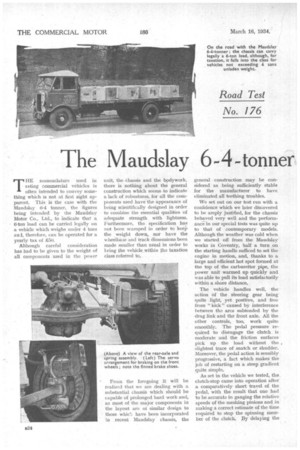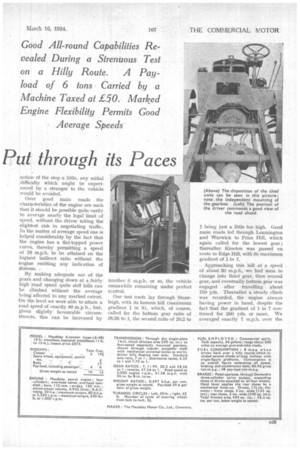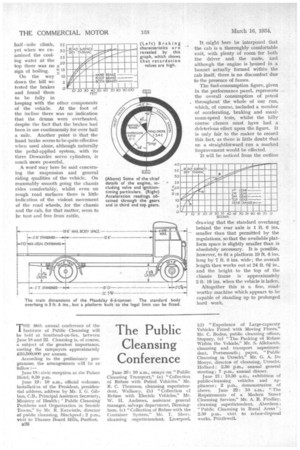The
Page 34

Page 35

Page 36

If you've noticed an error in this article please click here to report it so we can fix it.
Maudslay 6-4tonne(
Put through its Paces
Good All-round Capabilities Re vealed During a Strenuous Test on a Hilly Route. A Pay load of 6 tons Carried by a Machine Taxed at £50. Marked Engine Flexibility Permits Good Average Speeds Road Test No. 176
THE nomenclature used in rating commercial vehicles is often intended to convey something which is not . at first sight apparent. This is the case with the Maudslay 6-4 tonner, the figures being intended by the Maudslay Motor Co., Ltd., to indicate that a 6-ton load can be carried legally on a vehicle which weighs under 4 tons an therefore, can be operated for a yearly tax of :650.
Although careful consideration has had to be given to the weight of all components used in the power unit, the chassis and the bodywork, there is nothing about the general construction which seems to indicate a lack of robustness, for all the components used have the appearance of being scientifically designed in order to combine the essential qualities of adequate strength with lightness. Furthermore, the specification has not been scamped in order to keep the weight down, nor have the wheelbase and track dimensions: been made smaller than usual in order to bring the vehicle within the taxation class referred to.
From the foregoing it will be realized that we are dealing with a substantial chassis which should be capable of prolonged hard work and, as most of the major components in the layout are of similar design to those whicL have been incorporated in recent Maudslay chassis, the general construction may be considered as being sufficiently stable for the manufacturer to have eliminated all teething troubles.
We set out on our test run with a confidence which we later discovered to be amply justified, for the chassis behaved very well and the perform,. ance in our special tests was quite up to that of contemporary models. Although the weather was cold when we started off from the Maudslay works in Coventry, half a turn on the starting handle sufficed to set the engine in motion, and, thanks to a large and efficient hot spot formed at the top of the carburetter pipe, the power unit warmed up quickly and was able to pull its load satisfactorily within a shore distance.
The vehicle handles well, the action of the steering gear being quite light, yet positive, and free from " kick " caused by interference between the arcs subtended by the drag link and the front axle. All the other controls, too, work quite smoothly. The pedal pressure required to disengage the clutch is moderate and the friction surfaces pick up the load without the slightest trace of snatch or shudder. Moreover, the pedal action is sensibly progressive, a fact which makes the job of restarting on a steep gradient quite simple.
As set in the vehicle we tested, the clutch-stop came into operation after a comparatively short travel of the pedal, with the result that one had to be accurate in gauging the relative speeds of the meshing pinions and in making a correct estimate of the time required to stop the spinning member of the clutch. By delaying the action of the stop a little, any initial difficulty which might be experienced by a stranger to the vehicle would be avoided.
Oyer good main roads the characteristics of the engine are such that it should be possible quite easily to average nearly the legal limit of speed, without the driver taking the slightest risk in negotiating traffic. In the matter of average speed one is helpCd considerably by the fact that the engine has a flat-topped power curve, thereby permitting a speed of 28 m.p.h. to be attained on the highest indirect ratio without the engine emitting any indication of
distress. .
Byl making adequate use of the gears and changing down at a fairly high Iroad speed quite stiff hills can be Climbed without the average being affected to any marked extent. On the level we were able to attain a road speed of exactly 40 m.p.h., but, given slightly favourable circumstances, this can be increased by another 6 m.p.h. or so, the vehicle meanwhile remaining under perfect ccntrol.
Our test route lay through Stoneleigh, with its famous hill. (maximum gradient 1 in 9), which, of course, called for the. bottom gear ratio of 38.36 to 1, the second ratio of 20.2 to
1 being just a little too high. Good main roads led through Leamington and Warwick to Frizz Hill, which again called for the lowest gear ; thereafter Kineton was passed en route to Edge Hill, with its maximum gradient of 1 in 7.
Approaching this hill at a speed of about 30 m.p.h., we had soon to change into third gear, then second gear, and eventually bottom gear was engaged after travelling about 150 yds. Thereafter a steady climb was recorded, the engine always baying power in hand, despite the fact that the gradient of 1 in 7 continued for 200 yds. or more. We averaged exactly 7 m.p.h. over the half mile climb, 55 yet when we ex30 amined the cool
mg water at the ao
top there was no ±
sign of boiling. 15 On the way 10
down the hill we tested the brakes and found them to be fully in keeping with the other components of the vehicle. At the foot of the incline there was no indication that the drums were overheated, despite the fact that the brakes had been in use continuously for over half a mile. Another point is that the hand brake seems to be quite effective when used alone, although naturally the pedal-applied system, with its three Dewaridre servo cylinders, is much more powerful.
A word may here be said concerning the suspension and general riding qualities of the vehicle. On reasonably smooth going the chassis rides comfortably, whilst even on rough road surfaces there is little indication of the violent movement of the road wheels, for the chassis and the cab, for that matter, seem to be taut and free from rattle.
It might here be interposed . that the cab is a thoroughly comfortable unit, with plenty of room for both the driver and the mate, and although the engine is housed in a bonnet actually formed within the cab itself, there is no discomfort due to the presence of fumes.
The fuel-consumption figure, given in the performance panel, represents the overall consumption of petrol throughout the whole of our run, which, of course, included a number of accelerating, braking and maximum-speed tests, whilst the hilly course chosen must have had a deleterious effect upon the figure. It is only fair to the maker to record this fact, as there is little doubt that on a straightfdrward run a marked improvement would be effected.
It will be noticed from the outline drawing that the standard overhang • behind the rear axle is 1 ft. 6 ins. smaller than that permitted by the regulations, so that the available platform space is slightly smaller than is absolutely necessary. It is possible, however, to fit a platform 19 ft. 6 ins. long by 7 ft. 6 ins. wide ; the overall length then works out at 24 ft. 0# in., and the height to the top of the chassis frame is approximately 2 ft. 10 ins, when the vehicle is laden.
Altogether this is a fine, roadworthy machine which appears to be capable of standing up to prolonged hard work.




















































































